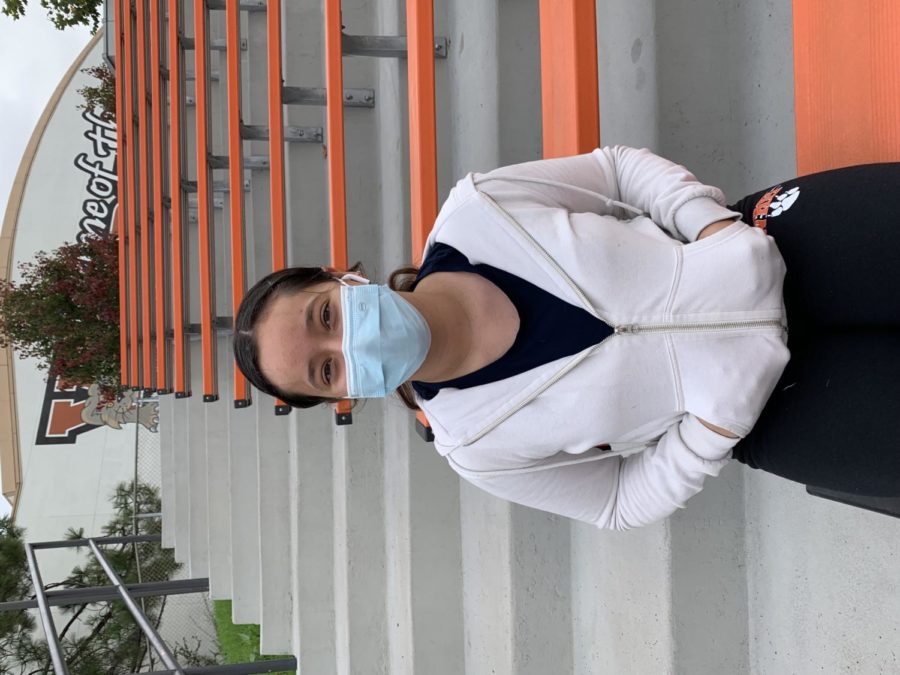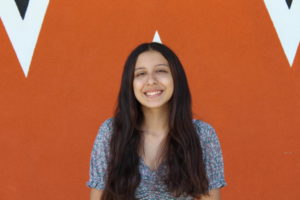This article is written in English below.
Muchos estudiantes de Woodside que son inmigrantes o provienen de otros países luchan para tener un mejor futuro.
En Woodside hay un gran porcentaje de estudiantes que luchan para aprender Inglés. Hay muchos inmigrantes en el área de la bahía y hay muchos estudiantes que son parte de ese porcentaje. En Woodside, 13% de la escuela son estudiantes aprendiendo inglés en las clases de ELD.
Emily Peña, una estudiante de segundo año en Woodside, llegó a los Estados Unidos hace tres meses.
“Vine para agarrar un futuro mejor y aprovechar [de] los recursos que hay aquí,” dijo Peña. “Donde estaba no había muchos.”
Antes de llegar a los Estados Unidos, Peña vivía en Michoacán, México. Ella se siente muy feliz de estar aprendido Inglés.
“La comunidad me ha ayudado porque he aprendido más cosas que antes no sabía,” dijo Peña. “Siento que he aprendido mucho más y me han tratado bien.”
Aunque Peña ha aprendido mucho, ella todavía extraña dónde vivía antes. Peña extraña sus costumbres, fiestas, sus amigos y su familia. Hay aspectos positivos y negativos de donde ella vivía.
“Allá había mucha inseguridad y aquí me siento más segura,” dijo Peña. “Acá hay muchas más cosas que hacer qué allá.”
Peña se siente afortunada de tener la oportunidad de aprender un nuevo idioma pero, ella ha pasado por algunas dificultades aprendiendo inglés.
“Lo más difícil ha sido el inglés,” dijo Peña. “[En] tratar de hablarlo, o entenderlo.”
Después de haber pasado por muchos cambios, ella espera que otras personas en su situación se esfuercen para lograr un cambio. Muchas personas han ayudado a Peña y se siente muy agradecida que la gente la haya ayudado.
Christopher Mourra, un estudiante de primer año de Woodside vino a los Estados Unidos por dos razones.
“En primer lugar vine para estudiar,” dijo Mourra. “En segundo para trabajar.”
Mourra viene de Honduras y está aprendiendo inglés en Woodside.
“Quiero aprender inglés para poder hablar con mis amigos mejor,” dijo Mourra. “Aparte de mejorar el inglés, [Woodside] me ha enseñado muchas cosas.
Jonda Farris De Gámez, una maestra en Woodside, enseña ELD y Español. A ella le gusta enseñar idiomas porque puede ayudar a los estudiantes a conectarse.
“El propósito número uno de cualquier clase de idioma es interactuar con otras personas, conocer otras culturas, y otros puntos de vista.” dijo Farris De Gámez.
Para Farris De Gámez las escuelas son una parte importante porque de niña la escuela era un escape para ella.
“Como muchos hogares tuvimos algunas situaciones desafiantes, tengo dos hermanos con discapacidades y mi madre era madre soltera [con] cuatro hijos,” dijo Farris De Gámez. “Hubo muchas cosas difíciles y para mí la escuela me dio la oportunidad de ser yo misma, aprender y elegir a dónde quería ir.”
La escuela siempre fue un buen lugar para Farris De Gámez porque la escuela fue un lugar donde ella tenía mucha libertad. Cuando ella se recibió de maestra, busco oportunidades para ayudar a los estudiantes como los maestros la ayudaron cuando ella era pequeña. Farris De Gámez enseña ELD 1 y nota que los estudiantes tienen mucho en común.
“Tienen en común todas las esperanzas, miedos y aspiraciones de ser adolescente,” dijo Farris De Gámez. “Tienen en común el deseo de hacer el bien y ser buenos.”
Los estudiantes inmigrantes comparten experiencias y retos que otra gente no comprende.
“Un estudiante inmigrante ha vivido tantas cosas más allá de sus años. Es increíble lo mucho que aguantan y cuánto tienen que superar,” dijo Farris De Gámez. “Hay tanto miedo, es un momento difícil para muchos niños.”
Farris De Gámez describió la diferencia entre aprender un idioma y depender de un idioma.
“Para los estudiantes inmigrantes es muy diferente de los estudiantes que están tomando español, francés, chino o latín porque ellos no dependen en eso para hacer todo en la escuela,” dijo Farris De Gámez. “Ellos no dependen de esos idiomas para buscar trabajo [y] para interactuar con la gente de la comunidad.”
Muchos inmigrantes batallan aprendiendo inglés pero, tienen una inspiración inmensa.
“Nuestros inmigrantes vienen con la más absoluta necesidad y deseo de hablar un idioma,
es difícil para ellos, pero también es emocionante.” dijo Farris De Gámez.
English Translation:
Many Woodside students who are immigrants or from other countries struggle for a better future.
At Woodside, a large percentage of students struggle to learn English. At Woodside, 13% of the school are English learners in ELD classes.
Emily Peña, a sophomore at Woodside, arrived in the United States three months ago.
“I came to seize a better future and take advantage [of] the resources that are here,” Peña said. “Where I was, there weren’t many.”
Before arriving in the United States, Peña lived in Michoacán, México. She’s excited about learning English.
“The community has helped me because I have learned new things I didn’t know before,” Peña said. “I feel like I have learned a lot more and I have been treated well.”
Although Peña has learned so much, she still misses where she used to live. Peña misses her customs, parties, her friends, and family. There are many positive and negative aspects about where she used to live.
“[In Michoacán, México,] there was a lot of insecurity and here I feel safer,” Peña said. “There are many more things to do here than there.”
Peña feels lucky enough to have the opportunity to learn a new language, but she’s had some difficulties learning English.
“The hardest thing has been the English,” Peña said. “[In] trying to speak it, or understand it.”
After going through many changes, she hopes that other people in her situation will work hard to make a change. Many people have helped Peña and she feels very grateful that people have helped her.
Christopher Mourra, a freshman at Woodside, came to the United States for two reasons.
“First of all I came to study,” Mourra said. “Secondly, to work.”
Mourra comes from Honduras and is learning English at Woodside.
“I want to learn English so I can talk to my friends better,” Mourra said. “Besides improving my English, [Woodside] has taught me a lot of things.”
Jonda Farris De Gámez, a teacher at Woodside teaches ELD and Spanish. She likes teaching languages because she can help students connect.
“The number one purpose of any kind of language class is to interact with other people, get to know other cultures, and other viewpoints,” Farris de Gámez said.
For Farris De Gámez schools are an important part because as a child, school was an escape for her.
“Like many households we had some challenging situations, I have two brothers with disabilities and my mother was a single mother [with] four children,” Farris De Gámez said. “There were many difficult things and for me, school gave me the opportunity to be myself, learn and choose where I wanted to go.”
School was always a good place for Farris De Gámez because she had a lot of freedom at school. When she received her teacher certification, she looked for opportunities to help students, just like how teachers helped her when she was little. Farris De Gámez teaches ELD 1; she noticed that students have a lot in common.
“They have in common all the hopes, fears, and aspirations of being a teenager,” Farris De Gámez said. “They have in common the desire to do good and be good.”
Immigrant students share experiences and challenges that other people don’t understand.
“An immigrant student has experienced so many things beyond his years. It’s incredible how much they endure and how much they have to overcome,” Farris De Gámez said. “There is so much fear, it’s a difficult time for many children.”
Farris De Gámez described the difference between learning a language and depending on a language.
“For immigrant students it’s very different from students who are taking Spanish, French, Chinese or Latin because they don’t depend on it to do everything at school,” Farris De Gámez said. “They don’t depend on those languages to look for work [and] to interact with people in the community.”
Many immigrants struggle learning English but are immensely inspired because they want a better future.
“Our immigrants come with the utmost need and desire to speak a language, it’s difficult for them, but it’s also exciting,” Farris De Gámez concludes.









